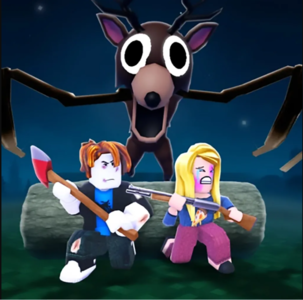99 Nights in the Forest: A Psychological Survival Journey Through Darkness
Meta Description:
Explore the haunting world of 99 Nights in the Forest, a gripping psychological survival game blending horror, strategy, and emotional storytelling across a nightmarish landscape.
There are games that frighten you, and then there are games that quietly crawl under your skin and stay there. 99 Nights in the Forest belongs to the latter category — a survival-horror experience that eschews jump scares in favor of lingering dread, existential decisions, and psychological decay. You’re not just trying to survive the forest — you’re trying to survive your own mind.
Set in an ever-shifting woodland cursed by ancient forces and haunted by personal demons, the game tasks players with surviving for 99 nights in isolation, with dwindling resources and mysterious threats stalking their every move. It's a game about endurance, both physical and emotional, where every night survived feels like a small victory against an overwhelming void.
1. The Origins of 99 Nights in the Forest
The concept for 99 Nights in the Forest came from a solo indie developer inspired by games like Don't Starve, Darkwood, and Pathologic. The result was something deeply personal — a survival game that also serves as a metaphor for trauma, loss, and self-recovery.
A Game Built on Solitude
Rather than relying on traditional horror tropes, the developer leaned into slow-burn dread. The forest isn't just dark — it's alive, whispering, changing. The idea was to simulate what it means to be truly alone with your thoughts, your fears, and your regrets.
A Spiritual Successor to Atmospheric Survival Games
Fans of mood-driven games will recognize elements from The Long Dark and Dark Souls in its unyielding tone and cryptic world design. But 99 Nights carves out its own niche with emotional storytelling and day-to-night progression.
2. Game Premise: Survive 99 Nights, If You Can
There are no big objectives, no clear endgame. Your goal is simple: survive. But doing so for 99 nights in a cursed forest is anything but straightforward.
Real-Time Progression
Every night brings new threats — changing weather, shifting paths, psychological hallucinations. The player has to scavenge during daylight, build shelter, and fend off dangers at night.
The Loop That Evolves
At first, the gameplay loop is familiar: gather, build, hide. But by night 30, the forest starts behaving differently. Landmarks shift. Memories appear as interactive illusions. Nightmares become real enemies.
3. A Living Forest: More Than Just a Setting
The forest in this game is its most important character. It grows, learns, and reacts to your presence.
Environmental Storytelling
There are no direct lore dumps. Instead, players discover abandoned campsites, scratched journal entries, and ghostly echoes that reveal the forest’s history — and maybe yours.
Dynamic Ecosystem
The flora and fauna aren’t just set pieces. Some plants heal, others poison. Animals behave differently based on time of day, weather, and even how much you’ve disturbed their habitats.
4. Psychological Decay and Sanity Mechanics
One of the game’s standout features is its sanity system, which affects visuals, audio, and interactions based on how long you’ve been alone — and what you’ve done to survive.
Seeing Isn’t Believing
Low sanity triggers hallucinations. Trees bleed, voices whisper, familiar faces appear in the fog. You’ll question what’s real — and the game never answers.
Morality Affects Your Mind
The game tracks your moral choices. Did you eat the trapped animal or let it go? Did you burn an effigy for warmth or bury it? These decisions affect your sanity and unlock different nightmare sequences.
5. Sound and Atmosphere: The Heartbeat of Dread
The audio design is arguably one of the most powerful elements of 99 Nights in the Forest. There’s very little music — just ambient sounds and your own breathing.
Audio as a Gameplay Mechanic
Footsteps in the distance? Real threat or hallucination? Players must listen carefully to differentiate between real enemies and mental noise. Headphones are not just recommended — they’re required.
Minimalist, Yet Terrifying
The silence between sounds is as important as the noise. It's this restraint that builds unbearable tension and keeps you checking over your shoulder.
6. Combat and Survival Mechanics
Unlike most survival games, 99 Nights in the Forest does not empower the player with weapons. Combat is discouraged, and running is often the smartest option.
Tools, Not Weapons
You can craft torches, traps, and distractions, but there’s no shotgun or sword. The game wants you to feel powerless — and you will.
Hunger, Cold, and Exhaustion
Managing your health isn’t just about HP. You’ll need to eat, stay warm, and get rest — but each of those comes with risk. Firelight might keep you warm, but it attracts… things.
7. Narrative: A Story Hidden in the Shadows
99 Nights in the Forest tells a story, but not in the way most games do. It’s non-linear, interpretive, and hidden in symbolism.
Who Are You, Really?
Players start with little context. But as nights pass, flashes of memories begin to surface. Are you fleeing from something? Searching for someone? The forest holds the answers — and it doesn’t give them easily.
Multiple Endings
There are several conclusions, based on how you behave, what you find, and your final mental state. Some are cathartic, others devastating. Few are happy.
8. Art Direction: Handcrafted Horror
The game blends hand-drawn textures with atmospheric lighting and a muted color palette. The visual design reinforces the feeling of isolation and instability.
Minimal UI, Maximum Impact
There’s no HUD clutter. Just a flickering torchlight, your breath in the cold, and the shadows that move when you’re not looking.
Symbolism in Design
From the twisted trees to the shape of the moon, everything is carefully designed to echo themes of grief, guilt, and transformation.
9. Player Community and Modding Scene
Despite its dark tone, 99 Nights in the Forest has cultivated a strong, passionate community that shares theories, mods, and custom challenges.
Fan Interpretations
Theories abound — is the forest purgatory? Are you dead? Are the nightmares manifestations of trauma? The game offers just enough ambiguity to fuel deep Reddit threads and YouTube essays.
Custom Mods
Some players have added custom sanity effects, new endings, or alternate forests. While unofficial, these mods extend the game’s replayability and creative depth.
10. The Long Night Ahead: Longevity and Impact
99 Nights in the Forest isn’t for everyone — but for those it speaks to, it leaves a mark. It’s a masterclass in using minimal resources to create maximal psychological impact.
Endurance, Not Enjoyment
This game isn’t “fun” in the traditional sense. It’s compelling, immersive, and emotionally exhausting — in a good way. Every night survived feels like a real triumph.
A Modern Cult Classic
While it may never top mainstream charts, the game has carved a deep niche in the indie horror space. It’s already being compared to Darkwood, INSIDE, and Amnesia for its quiet brilliance.
Final Verdict
99 Nights in the Forest is an unforgettable journey into the heart of darkness — both literal and psychological. It doesn’t try to entertain in traditional ways. Instead, it invites players to sit with discomfort, endure solitude, and question their own memories. If you’re looking for a unique survival experience with artistic ambition and emotional weight, this is a game worth every sleepless night.
























